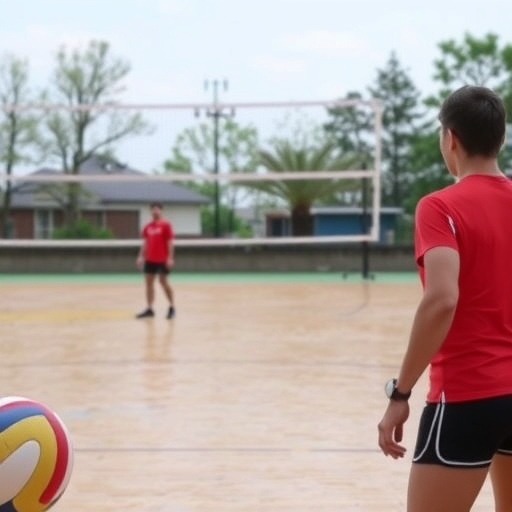In a groundbreaking advancement in the realm of sports technology, researchers led by Sun, T., He, X., and Zhang, J. have introduced an innovative approach to enhance the training experience for volleyball players through the development of an automatic serving method that employs an enhanced YOLOv5 framework and an improved Hough transform algorithm. The sheer complexity and challenge of perfecting a volleyball serve make this advancement not only timely but also necessary in a sport where precision and consistency are paramount to success.
The automatic serving method being presented marks a significant shift in how training can be approached, integrating state-of-the-art artificial intelligence techniques to optimize performance. By harnessing the capabilities of the improved YOLOv5 model, the researchers aimed to elevate the standard of volleyball training robots, allowing for a level of interaction and feedback that has traditionally been challenging to achieve. YOLOv5, known for its efficiency in object detection, becomes central to this approach by enabling the robot to identify the positioning and movement of the player and the ball with remarkable accuracy.
At the core of this new training method is the enhanced Hough transform, an algorithmic technique recognized for its efficacy in detecting shapes within images. By applying improvements to this transform, the researchers were able to significantly boost the robot’s ability to interpret the environment and analyze player movements in real-time. This ensures that the serving mechanism is not only reactive but also predictive, adapting to the player’s actions and providing tailored training scenarios that can lead to faster improvement rates.
The implications of this automatic serving method extend beyond merely delivering balls with precision. It signifies a paradigm shift in training methodologies, where athletes can receive instant feedback and adjust their techniques accordingly. Traditional training regimens often lack the immediate analytical component that technology can provide. With this robot, players can refine their skills faster while also minimizing the risk of injury caused by repetitive motion through overtraining.
Central to the design of the volleyball training robot is the need for adaptability. The improved YOLOv5 model plays a crucial role in this aspect by maintaining the agility required to keep pace with the dynamic nature of volleyball. The versatility coupled with the enhancements in movement recognition through the Hough transform allows the robot to execute varied serving techniques, essentially mimicking numerous styles and strategies employed by real players.
The experimental validations outlined by the researchers demonstrate the profound accuracy of this new training tool. By conducting various sessions with athletes of differing skill levels, the results showcased significant improvements in serving skills, underscoring the efficacy of employing machine learning in sports. Such quantitative results provide a compelling case for the integration of similar technologies in the realms of coaching and athlete development.
Moreover, this presentation of an automatic serving robot raises essential questions regarding the future of coaching in sports. As artificial intelligence continues to evolve, one might wonder about the role of human coaches alongside this technology. The balance of technology-assisted training with personal coaching could lead to a hybrid instructional approach that utilizes the strengths of both paradigms.
Furthermore, the potential for such technology extends well beyond volleyball. The algorithms and methodologies derived from this research could be applied across various sports, suggesting a monumental leap towards the evolution of training for diverse athletic disciplines. The development of performance-enhancing robots can significantly reduce the time and effort traditionally required for athletes to reach their peak potential.
As competitive sports increasingly embrace technological advancements, this research opens avenues for future inquiries that examine not just improvement in athletic performance but also psychological factors shaped by high-tech training methods. Understanding how athletes interact with computerized training partners could yield insights that redefine competitive sports as we know them.
The road ahead promises further innovations in the intersection of sports and technology. With the increasing integration of artificial intelligence into physical training environments, we stand on the precipice of a transformation in athlete development. The enhanced automatic serving method presented by Sun and colleagues offers just a glimpse of what may come, as researchers and engineers collaborate to push the boundaries of what machines can do in the support of human athletic prowess.
Experts anticipate that such innovations will spur additional research into the development of robotic systems tailored specifically for different sports, creating a comprehensive landscape of athletic development tools. With the continued advancements in computer vision and machine learning, the next generation of performance training might look incredibly different from today.
In conclusion, the strides made by Sun, T., He, X., and Zhang, J. in designing an automatic volleyball serving robot underscore the transformational impact of technology on sports training. As these researchers unveil their automatic serving method, they not only illuminate the potentials of machine learning in athletic training but also pave the way for future discourse on technology’s role in enhancing human performance.
Subject of Research: Development of an automatic volleyball training robot utilizing improved YOLOv5 and Hough transform.
Article Title: Automatic serving method of volleyball training robot based on improved YOLOv5 and improved Hough transform.
Article References:
Sun, T., He, X. & Zhang, J. Automatic serving method of volleyball training robot based on improved YOLOv5 and improved Hough transform.
Discov Artif Intell 5, 196 (2025). https://doi.org/10.1007/s44163-025-00450-2
Image Credits: AI Generated
DOI: 10.1007/s44163-025-00450-2
Keywords: Volleyball, training robot, YOLOv5, Hough transform, artificial intelligence, sports technology, performance improvement.




